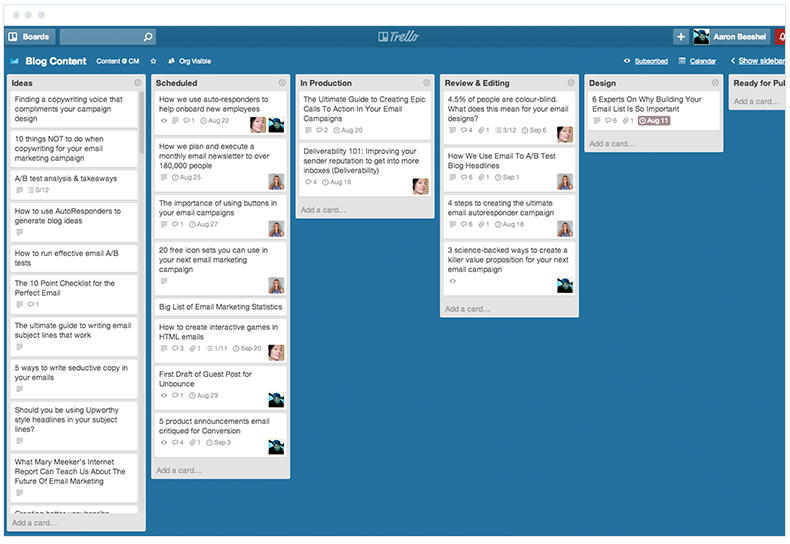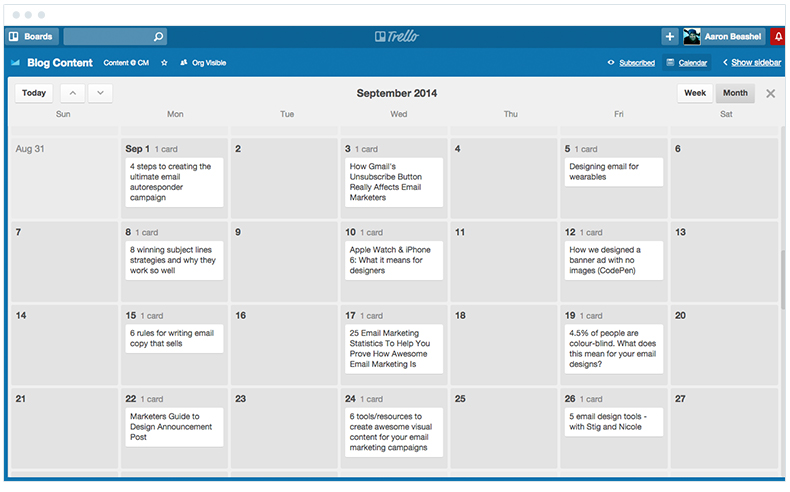
Content marketing can be an incredibly successful approach to customer acquisition for B2B SaaS companies.
And there is a lot of content out there that can teach you how to do it effectively as well, with the likes of HubSpot, Marketo and Kapost all producing great content that’ll help you create a winning content marketing strategy for your company.
However, I’ve found there is a lot less content around how to actually execute content marketing on a day to day basis.
So in this post, I wanted to share with you the process we use to manage our content machine in the hope you can take away some ideas that’ll help you manage your own.
What content at Campaign Monitor looks like
Before diving in to our process though, I wanted to give you some insight into what content marketing looks like at Campaign Monitor.
In terms of velocity, our (rough) monthly schedule is as follows:
- Publish 3-4 blog posts per week
- Publish 3-4 new Gallery entries per week
- Publish 1 new guide/eBook per month (our latest one on list building is 6000 words and is a collaboration with Noah Kagan and the SumoMe team).
- Publish up to 150 posts on our social media accounts per month
- Send over 250,000 emails across 15+ campaigns each month.
It’s a lot of content we’re putting out there, and we have a total commitment to quality as well which – although totally necessary – makes it even more of a mountainous task.
To top it all off, we do it with a team of just one and a half people. I’m pretty much solely focused on content while our Community Manager, Ros, splits her time 50/50 between content related tasks like managing our social media accounts and non-content related tasks like organising sponsorships, speaking at events, etc.
Our Process
So how do we do it? Let’s take a step by step look at out process:
1. Ideas
The whole process of planning and publishing content starts with ideas. As mentioned before, we currently publish on the blog 3 – 4x per week and create longer guides once per month. So how do we come up with ideas for all this content?
By reading.
I personally subscribe to over 50 marketing blogs via Feedly, and I’ll read nearly every post they publish. These blog posts cover topics such as conversion rate optimization, copywriting, content marketing, and more.
The posts I read on other blogs serve as inspiration for the Campaign Monitor blog content. If I see a great tip on conversion rate optimization that’s also applicable to email marketing, I’ll repurpose it with an email marketing focus and turn it into a blog post.
When ideas come our way, we add them to a Trello board to keep them all in one place. Trello is an amazing tool for this, not only does it have apps for every device (which is great for when ideas come to you on the go) but each board has it’s own email address, so whenever I read an interesting article that we might be able to use on the blog, I email it to the board with a few comments.

On top of that, we’ll also use tools like BuzzSumo and SEMRush to find content that has performed well on other blogs in the past, and then add those to the ideas column with an email marketing focus applied.
2. Planning
At the end of each month, I’ll sit down with our Ros (virtually, as I’m in Sydney and she’s in San Francisco) and we’ll plan out the content for the next month.
This usually involves looking through the idea list and moving any concepts we like into the ‘Scheduled’ column. We’ll then assign them all a due date and an author (typically either Ros or me) and build out the Editorial Calendar for the month.

Once we’ve planned the blog content for the month, we’ll use that framework to start planning out our email campaigns, namely the newsletter and lead nurturing campaigns, as they primarily feature content from the blog.
To do this, we’ll look at what content we have coming up and choose the most relevant articles for each list we send too.
Once we’ve worked what content goes in each, we’ll actually create a wireframe for each campaign, outlining the articles that go into it and the copy we’ll use. This helps us visualise what is going out and ensure we’re creating a good user experience for our subscribers (being an email marketing company, it’s critical we’re leading by example when it comes to email best practices).

Finally, we’ll also plan out our major guide for that month. We’ll pick a topic that we want to take a deep look at (such as list building) and plan out the structure for the guide usually by writing the table of contents and a basic synopsis for each chapter. We’ll also plan the promotional activities around it, such as social media posts, blog posts, emails, guest posts, paid advertising, etc.
The reason we do all of our planning in one go is two-fold:
- It all ties together – By planning everything at once, we’re able to make the most of each channel to cross-promote our content. For instance, if we are planning to publish a guide on list-building around the middle of the month then it’s the perfect thing to fit in our Newsletter at the end of the month, and also can be repurposed into one or two different blog posts (which need to be planned in to the editorial calendar)
- It gives us our run sheet for the month – By planning everything at the beginning of the month, everybody is clear what needs to be produced and when and there are no surprises or missed deadlines (though there are definitely still some tight ones). It also gives other people involved in the process (such as our design team) a good idea of what’s coming up that month that they’ll need to work on.
3. Production
Once planning is done, we move on to actually writing the content. This is basically an ongoing process throughout the entire month, and we aim to have a first draft of each blog post done a week before publish date in order to allow for editing time and design work.
Generally speaking we’ll work through 2 or 3 rounds of writing for each content piece (or at least I do anyway). The first is just a massive dump of information into a page. It’s often terribly worded and full of mistakes, but the goal is just to get research and information onto the page.
The next round will focus on making that huge dump of information legible, and will often involve rewriting sections so that it flows better and is a much more refined and focused read.
The final round is usually proofing the copy for spelling and grammar errors and optimising for longtail SEO. We try to always get someone else to do this part as it’s very hard to proof your own work. We also use tools like Grammarly which has been a big help in picking up the little things we humans tend to skim over.
4. Design
Campaign Monitor is an extremely design-focused company, and we’re fortunate to have an incredible team of designers who work on almost every piece of content that goes out to ensure any images, graphs, etc all look amazing.
So the final step before anything goes out the door is handing it over to them to work their magic. They live inside Basecamp, so this usually means jumping in and creating some tasks before the studio manager picks them up and assigns them to one of the designers.
5. Publishing
Once a piece of content has been reworked by the designers, it’s back over to us to publish it. This is pretty straight forward, so I won’t go into too much detail here.
6. Promotion
Once a piece of content has been published, we’ll get to work promoting it. Depending on the type of content it is, we leverage a variety of channels, including:
- Social media – We use Buffer to manage our social media posting and will usually schedule 4-5 tweets for each blog post as well a 1-2 shares on Facebook and LinkedIn. We’ll do most of the sharing activity in the first week the post is launched, then spread out other activity up to a month after it goes out.
- Email – We create and send an email campaign to our blog subscribers list every time we publish a new post (on top of the newsletter and lead nurturing emails discussed earlier). We used to do this automatically using the RSS to email feature, but found that doing it manually allowed us to run a number of A/B tests which have significantly improved our click-through rate. We’ll also A/B test blog post headlines using the email subject line, which has proven to be highly effective as well.
- Partnerships – We try to leverage partnerships with other influencers and organisations as much as possible, as it’s a great way to get our content in front of their existing audiences. We’ve worked with Neil Patel, Joe Pulizzi, Noah Kagan, Unbounce, Shopify, SumoMe & more to do this and it’s been very effective.
6. Reporting
The final piece of the process is reporting. Although we’ll keep an eye on our analytics tools all month, we do most of our formal reporting on our content marketing efforts at the end of each month.
We initially started off measuring the basics like traffic, email subscribers, signups & customers but found this aggregate view wasn’t really telling us much. The numbers would go up and down month to month and we had no real indication of why it happened, what to do about it, or whether it was even a bad thing.
So we recently changed it up and are more focused on measuring content’s contribution to our wider metrics. So we now measure things like:
- Contribution to total sitewide sessions
- Contribution to total sitewide signups
- Contribution to total sitewide customers
- Year over year growth in sessions
- Year over year growth in signups
- Year over year growth in customers
- Growth per channel
- Growth per content type
This is measured in a custom-built spreadsheet that pulls from our internal databases as well as Google Analytics.
This refined focus on contribution to total has been a much better approach. We’re not publishing content in a vacuum, and our numbers are heavily swayed by seasonality, search trends, changes to social media platforms and a host of other factors, so by looking at it from a contribution to total perspective we can help reduce the effect of these factors.
Another big change we’ve made recently is starting to focus on ‘number of people helped’ which we measure through comments and tweets like these:
- “I like it. Picked up a trick I can use on the next email blast.. Thanks for the insight”
- “Gosh, @campaignmonitor just produces such great content. Thanks guys!”
- “You are the best!! i was struggling with the subject line for my follow up email and I landed here looking for ideas. Got a good one now :)”
We’re big believers in the content is customer success philosophy, so by incorporating ‘number of people helped’ into our key metrics it helps us focus on creating really great content that genuinely educates our audience, rather than just chasing numbers (although it sounds fluffy, it has had a significant impact on the type of content we produce).
On top of the spreadsheet mentioned above, we’ll also do monthly writeups on the internal wiki where we present the numbers back to the company and talk about a few of the things we achieved this month and what the plan is for next month.
In conclusion
It’s taken a few months to refine our process to here, and we have a little way to go still as we continue to learn.
In fact, just this month we made a change to the way we handover the newsletter and lead nurturing campaigns to the design team based on some inefficiencies and errors we identified in the process from the month before.
So while I’d encourage you to learn what you can from our process, your process will need to be different depending on the unique attributes and players within your organisation.
The best way to get it right is to outline a basic process to start with, get cracking producing content and then refine your process as you go.
Your turn: What other tricks and hacks do you have in your content production process? I’d love for you to share them in the comments below!


James
26.11.2014 at 07:41Super post Aaron,
Great to get these practical insights on your implementation process. You’re right, there’s not enough info around helping folks with the execution of an ongoing content marketing program.
Nice tip on Grammarly too – straight into Evernote!
Cheers,
James
Aaron Beashel
26.11.2014 at 07:56Hey James
Thanks so much taking the time to comment. I definitely found it was an area where information was a bit more lacking (at least compared to the vast amounts of information on content strategy anyway) so I’m glad you found it useful.
Ha, Yeah Grammarly has been a big saving grace for us so hopefully it’s a good addition to your toolkit as well.
Thanks again
Aaron
Justin McGill
26.11.2014 at 09:49Hey Aaron – love learning about how others develop and execute their content strategies.
I am curious if you had tested other days besides M/W/F for posting? Friday’s don’t seem to go as well for me, so I’m curious how you guys settled on the M/W/F schedule.
Kiran Kumar
28.11.2014 at 22:20Woah, all this by just 1 and half team! #Respect Aaron. This serves as a great benchmark. What’s true with me and I suspect with others too is that content distribution is more challenging than content creation. There are a few tips here, but maybe you could do a full post on that. Also it’d be great if you could share that list of 50 blogs on your Feedly list. Thanks for this though. I have bookmarked this for future reference .
Chandra
07.04.2015 at 13:20This is a fantastic post and a great look at your process. May we also suggest Scribendi.com for editing and proofreading? We have editorial staff available 24/7. We also have a WordPress plugin that allows you to send posts and pages for proofreading right from within the WP dashboard.
Miles Burke
14.06.2015 at 23:05Great post, Aaron, cheers. Sounds like a ton of content you’re juggling; well done! I’m also a fan of Trello for content calendar and story ideas, so good to see someone who works in content full time doing the same. Say G’day to Ben & Dave for me too 🙂
Why Your Blog Needs a Clear Process - Prepare.io Blog
14.12.2015 at 18:15[…] you’re looking for an example, here’s a good internal process. Here’s a few different examples from content teams I’ve worked […]